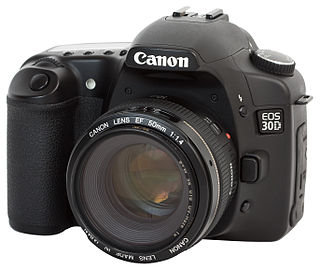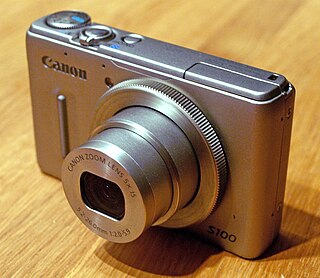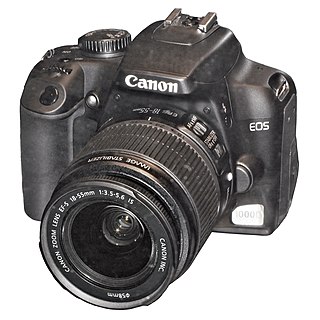Related Research Articles

Exchangeable image file format is a standard that specifies formats for images, sound, and ancillary tags used by digital cameras, scanners and other systems handling image and sound files recorded by digital cameras. The specification uses the following existing encoding formats with the addition of specific metadata tags: JPEG lossy coding for compressed image files, TIFF Rev. 6.0 for uncompressed image files, and RIFF WAV for audio files. It does not support JPEG 2000 or GIF encoded images.

The Canon EOS 10D is a discontinued 6.3-megapixel semi-professional digital SLR camera, initially announced on 27 February 2003. It replaced the EOS D60, which is also a 6.3-megapixel digital SLR camera. It was succeeded by the EOS 20D in August 2004.
Digital Negative (DNG) is a patented, open, lossless raw image format developed by Adobe and used for digital photography. Adobe's license allows use without cost on the condition that the licensee prominently displays text saying it is licensed from Adobe in source and documentation, and that the license may be revoked if the licensee brings any patent action against Adobe or its affiliates related to the reading or writing of files that comply with the DNG Specification. It was launched on September 27, 2004. The launch was accompanied by the first version of the DNG specification, plus various products, including a free-of-charge DNG converter utility. All Adobe photo manipulation software released since the launch supports DNG.

A geotagged photograph is a photograph which is associated with a geographic position by geotagging. Usually this is done by assigning at least a latitude and longitude to the image, and optionally elevation, compass bearing and other fields may also be included.

The Canon PowerShot G is a series of digital cameras introduced by Canon in its PowerShot line in 2000. The G series cameras are Canon's flagship compact models aimed at photography enthusiasts desiring more flexibility than a point-and-shoot without the bulk of a digital single-lens reflex camera.
The Extensible Metadata Platform (XMP) is an ISO standard, originally created by Adobe Systems Inc., for the creation, processing and interchange of standardized and custom metadata for digital documents and data sets.
Design rule for Camera File system (DCF) is a JEITA specification which defines a file system for digital cameras, including the directory structure, file naming method, character set, file format, and metadata format. It is currently the de facto industry standard for digital still cameras. The file format of DCF conforms to the Exif specification, but the DCF specification also allows use of any other file formats.
A camera raw image file contains unprocessed or minimally processed data from the image sensor of either a digital camera, a motion picture film scanner, or other image scanner. Raw files are named so because they are not yet processed and therefore are not ready to be printed, viewed or edited with a bitmap graphics editor. Normally, the image is processed by a raw converter in a wide-gamut internal color space where precise adjustments can be made before conversion to a viewable file format such as JPEG or PNG for storage, printing, or further manipulation. There are dozens of raw formats in use by different manufacturers of digital image capture equipment.

The Canon EOS 30D is an 8.2-megapixel semi-professional digital single-lens reflex camera, initially announced on February 21, 2006. It is the successor of the Canon EOS 20D, and is succeeded by the EOS 40D. It can accept EF and EF-S lenses, and like its predecessor, it uses an APS-C sized image sensor, so it does not require the larger imaging circle necessary for 35 mm film and 'full-frame' digital cameras.

The Canon PowerShot S100 is a high-end 12.1-megapixel compact digital camera announced and released in 2011. It was designed as the successor to the Canon PowerShot S95 in the S series of the Canon PowerShot line of cameras.

Digital Photo Professional (DPP) is the software that Canon ships with its digital SLR cameras for editing and asset management of its Canon raw (.CR2) files. It can also work with the older .CRW format of selected models, and also JPEGs and TIFFs from any source. The full version ships on a CD with the camera, and updates can be downloaded from Canon's website. Even though officially DPP only supports Windows and Mac operating systems, it is possible to run DPP on Linux systems by using Wine.
FastStone Image Viewer is an image viewer and organizer for Microsoft Windows, provided free of charge for personal and educational use, as of version 7.0. The program also includes basic image editing tools.
Tag Image File Format/Electronic Photography (TIFF/EP) is a digital image file format standard – ISO 12234-2, titled "Electronic still-picture imaging – Removable memory – Part 2: TIFF/EP image data format". This is different from the Tagged Image File Format, which is a standard administered by Adobe currently called "TIFF, Revision 6.0 Final – June 3, 1992".

The Canon PowerShot S200 is a high-end 10.1-megapixel compact digital camera announced and released in 2014 by Canon. The PowerShot S200 is a cheaper version of the Powershot S110, utilizing a 10.1 MP CCD instead of a 12 MP CMOS sensor. It is built as a smaller brother the S-series of the Canon PowerShot line of cameras. The S200 does not have RAW image file formatting.

dcraw is an open-source computer program which is able to read numerous raw image format files, typically produced by mid-range and high-end digital cameras. dcraw converts these images into the standard TIFF and PPM image formats. This conversion is sometimes referred to as developing a raw image since it renders raw image sensor data into a viewable form.

The Canon EOS 40D is a 10.1-megapixel semi-professional digital single-lens reflex camera. It was initially announced on 20 August 2007 and was released at the end of that month. It is the successor of the Canon EOS 30D, and is succeeded by the EOS 50D. It can accept EF and EF-S lenses. Like its predecessor, it uses an APS-C sized image sensor, resulting in a 1.6x field of view crop factor.

Canon EOS 1000D is a 10.1-megapixel digital single-lens reflex camera announced by Canon on 10 June 2008 and started shipping in mid August 2008. It is known as the EOS Kiss F in Japan and the EOS Rebel XS in the United States and Canada. The 1000D is an entry-level DSLR that has been described as being a step below the 450D.
Rawzor is a proprietary lossless image compression software which compresses camera raw images without any loss in image quality or meta-information. It is available for Microsoft Windows and Mac OS X.

The Canon PowerShot S95 is a high-end 10.0-megapixel compact digital camera announced and released in 2010. It was designed as the successor to the Canon PowerShot S90 in the S series of the Canon PowerShot line of cameras.

The Canon PowerShot S110 is a high-end 12.1-megapixel compact digital camera announced and released in 2012. It was designed as the successor to the Canon PowerShot S100 in the S series of the Canon PowerShot line of cameras.
References
- ↑ Phil Harvey (September 6, 2010). "CanonRaw Tags". ExifTool. Retrieved 18 October 2011.
- ↑ "CIFF Specification on Image Data File Version : 1.0 revision 4" Archived 2008-12-30 at the Wayback Machine . Canon Inc. (via Xyrion.org). December 24, 1997. Retrieved 2013-05-06.
- ↑ "Inside the Canon RAW format version 2, understanding .CR2 file format and files produced by Canon EOS Digital Camera". Lclevy.free.fr. Retrieved 2013-05-06.